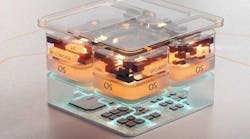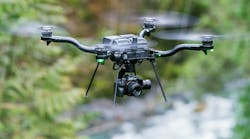By J.R. Wilson
In the post-Cold War era, the U.S. military has dominated the battlefield with increasingly sophisticated electronic systems. But new threats from terrorist organizations and "rogue nations" have introduced old weapons made new in the form of chemical and biological agents. The concern is not only how to protect humans from a direct attack, but how to decontaminate vital electronics quickly and safely afterward so they can still be used in a "shirt sleeve" environment.
All branches of the military rely on such equipment and the people who operate them, whether in a tank, in an aircraft or aboard a ship or submarine. But each of those operating environments offers its own set of complications when it comes to decontamination after a chemical or biological attack.
While gross decontamination such as washing the outside of an exposed tank has been part of military capability for some time, treating the delicate electronics gear inside that same tank, no matter how ruggedized the electronics may be, is an entirely different matter.
"I can field something right now that will decontaminate something, but when you're finished, the equipment isn't usable," says Col. Al Burnett, joint program manager for decontamination systems within the Joint Program Office-Chemical & Biological Defense at Brooks City-Base in San Antonio, Texas.
"We have to find something that won't corrode or interfere with the electronics and exotic materials that are out there. There are a number of existing systems that have been fielded, but for sensitive equipment, we really don't have a viable decontaminant to do that," he says.
The Air Force colonel is program manager for JPO-CBD's primary effort to combat that problem the Joint Service Sensitive Equipment Decontamination (JSSED) program, for which the Army's Edgewood Chemical Biological Center (Aberdeen Proving Ground, MD) is the lead agency, with all the services participating through a group of integrated product teams (IPTs).
Burnett is in charge of the Joint Service Sensitive Equipment Decontamination (JSSED) program, the JPO-CBD's primary effort to find ways of decontaminating sensitive electronics after a chemical or biological attack. The U.S. Army's Edgewood Chemical Biological Center at Aberdeen Proving Ground, Md., is the lead agency, with all the services participating through a group of integrated product teams (IPTs).
"If you're in an operation, we have individual protection equipment that would enable us to use equipment while it is contaminated, but to clean it up so a human can use it without that gear doesn't exist today," Burnett admits. "That's why there's a big need to get it done."
JSSED is structured today in three blocks. Block I calls for decontaminating sensitive equipment including electronics, avionics, environmental control systems, and life-support systems without affecting operational readiness, reliability or maintainability.
Block II looks at how to decontaminate the interiors of aircraft and vehicles, as well as cargo. This phase requires unique volumetric processing for all current and future military aircraft and vehicles. Block III, meanwhile, will address cleansing aircraft and vehicle interiors "on the move."
While progress has been made toward meeting Block I requirements, the technology to meet Block II and III is largely still in the laboratory. "For Block I, a closed loop system, the projected date to field a solution is somewhere around 2008," Burnett says. "We really don't have dates for the open loop system (Blocks II and III) right now."
Dishwasher safe
Block I has been likened to a dishwasher, a device small enough to mount on a Humvee and move to the scene of contamination, but only large enough to use for relatively small items such as night-vision goggles or portable global-positioning-system navigation units. Among the approaches under study is a recirculating solvent-wash sonicated-bath system that literally washes the contaminant away from the device, which can then be returned to use. Experts would deal with the contaminant and decontaminant in a separate part of the device.
For Blocks II and III, however, the decontamination process goes inside the system, which means the chem/bio agent and the decontaminant must be removed safely and thoroughly. That becomes even more difficult in Block III, because the system will not be in a contained location, but actually on the move. The ultimate test there, of course, will be aircraft in flight.
In all three blocks, however, the end goal is the same, says Adam Judd, research and development projects manager at Battelle Eastern Science and Technology Center's Engineering Applications and Operations Group in Aberdeen, Md. "We need to remove or destroy the agent, but keep the material available for immediate reuse without disrupting its function. For Block III, you're talking about a hand-held unit for spot decontamination or some physical process that could be integrated within the aircraft, something similar to a halon fire extinguisher."
Aircraft offer the greatest challenge and, in some ways, the greatest vulnerabilities. While other equipment may have been contaminated in a direct attack, an aircraft could be the subject of secondary contamination, such as while evacuating victims from a hotspot.
Even with the military's strict control of what comes into an aircraft, in some situations it may be impossible to avoid getting some chemical or biological agents inside. For the safety of the crew and those at the other end of the flight, decontamination would need to be done in the air, with everyone still inside.
While such weapons are unlikely to actually harm sensitive electronic equipment, the measures taken to remove them could. Standard decontaminants currently in use, such as high-test hypochlorite (HTH), super tropical bleach (STB), and decontamination solution 2 (DS-2), would render night-vision goggles, keyboards, and other computer components useless. Although such caustic agents have been in use for decades, they also are environmentally hazardous and potentially harmful to human skin, eyes, and lungs.
Experts at the Edgewood Center are developing more environmentally and human-friendly approaches based on enzymes, such as the advanced catalytic enzyme system (ACES) for use against nerve agents, militarized pesticides, bacteria, and anthrax spores.
"Catalytic enzymes are highly efficient, detoxifying many times their own weight of agent in seconds or minutes," according to a paper delivered by Edgewood scientists at the 23rd Army Science Conference in December 2002. "In addition, ACES will be noncorrosive, nonflammable and environmentally safe. ACES has the potential to fulfill a dual role as both decontaminant and fire extinguisher through the incorporation of environmentally benign fire-fighting materials."
While a process to destroy an agent on the surface would be ideal, it is also likely to damage the device being decontaminated.
"Ideally, the decontamination process would handle both chemicals and biologics," Judd says. "It's a removal process in the first step. The secondary process to destroy the agent may need to be different. But the primary goal is to quickly get the item back into the warfighters' hands.
"Some of the solvents we have looked at for Block I are potentials, with modifications, for II and III. But there are other approaches for II and III that are not even being considered for Block I, (because) removal alone is not a satisfactory approach. You will actually have to destroy the contaminant within the vehicle itself. That's why this is a more challenging effort and is lagging behind Block I."
For liquid chemical agents in Block II, Battelle experts are considering an approach involving heating the interior of an aircraft and all surfaces to a point just short of what would damage its electronic systems. The idea is to evaporate the agent, then use airflow to blow it into an external container. While such an approach would not harm equipment — providing the temperature threshold of the most vulnerable component was not exceeded. Drawbacks include the limited number of agents it could be used against and the fact it would not be practical for Block III.
Battelle experts are considering a vacuum approach against dry agents, such as anthrax spores. Contaminated surfaces would be sprayed with a mildly reactive decontaminant, which then would be vacuumed up, with little overall interaction with the device being treated.
"Something like a vaporous hydrogen peroxide might work on the agent and still be compatible with the surface being decontaminated. With that, you could cover a very large space with minimal amounts of decon agent," Judd says. "It's easy to imagine for II and III that the idea of having one solution that does everything would be a pretty strong technological challenge. At the current stage of the technology, however, a suite of solutions probably will be needed."
One agent that could handle chemical and biological hazards in all environments is the Holy Grail for researchers, but nothing at this stage appears to come even close. "In some cases, we are addressing bio agents with the same technology as chemicals," Burnett says, adding there are several problems to be overcome and ideal configurations to be designed.
"There is an issue on what to do with the hazardous waste once you decontaminate something. There is technology in the lab today to address that and completely eliminate or kill a chemical agent, leaving nothing harmful to a human or the equipment," Burnett says. "But that's just a lab experiment and today you have hazardous waste.
The JSSED team also recognizes that genetically altered biological agents are a much greater challenge than chemical weapons. "This is not a stagnant fight," Burnett says. "We can solve some things for today, but tomorrow there will be something new and we have to be ready to meet that challenge."
JSSED is a spiral development program; the first solution delivered may only be a partial solution. "It will be really interesting to see what happens in the next 10 years, which will probably see more technology maturing than we had in the past 100 years," Burnett says.


